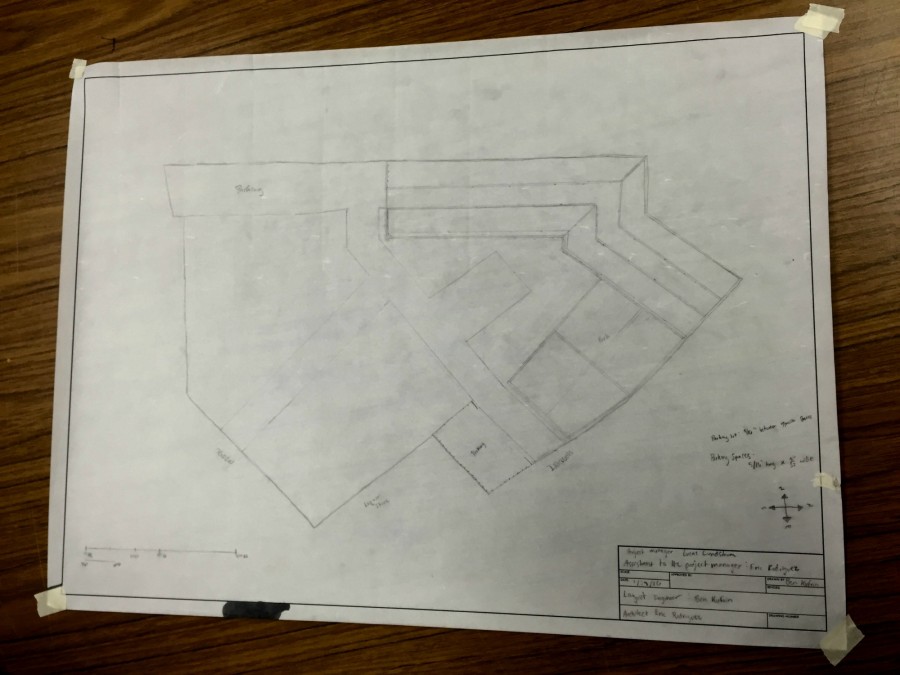Brainstorming a better Naperville
March 8, 2016
The blueprint Ben Kufrin, Lucas Lundstrum and Eric Rodriguez have been working on for their architectural drafting project.
Three Naperville North seniors, Ben Kufrin, Eric Rodriguez and Lucas Lundstrum, huddle around a long table, erasing and retracing lines. The piece of paper before them is more than just that–it’s a vision for the future.
In partnership with the City of Naperville and Newman Architecture, they are hatching up a blueprint for a more effective use of the space on the corner of Ogden and Iroquois, part of the assignment for this year’s architectural drafting competition. At the end of the semester, all seven groups involved will present their ideas to a panel of a dozen judges for consideration.
“In the future, we’ll be able to drive by this place and be like ‘wow, we definitely helped in that area in some way,’” Rodriguez said.
In previous years, the competition assignments ranged from designing facilities for the 2016 Olympics to a house of worship. Out of all 14 years of the project, this year’s project is bigger than ever, according to Rebecca DiOrio, NNHS applied science and architectural drafting teacher.
“A lot of the previous stuff has been one building, one style or one house. Now we’re working with 14 acres, which is a lot of land,” DiOrio said.
So far, DiOrio said the teams have come up with some creative ideas. But despite the inventiveness this project allows for, Kufrin said it has been tricky to work within the requirements.
“One of the first things [the City of Naperville] wanted to have within the design was residential homes or senior living,” Kufrin said.
Lundstrum agrees that the mandated components of the space have been difficult to work around.
“I don’t know why they need another senior home right next to the one down the street, but if they want it, we are going to give it to them,” Lundstrum said.
According to the class syllabus, topics covered in architectural drafting include computer aided drafting, energy efficiency, construction techniques and terminology, residential and commercial building design and interior design. Through the competition project, DiOrio said students work on a number of these skills.
“They’re given the problem and they have to start figuring it out,” DiOrio said. “I give them six to eight weeks to get their blueprints going. They also have to make a model of it. They have to do rendered drawings and that is basically taking paper and turning it into a 3D object.”
To start their blueprints, all seven teams took a field trip to the space on Ogden and Iroqious earlier this semester. Throughout the day, nearby residents came by to give the students input.
“They don’t want a lot of noise back there. They said they can manage delivery trucks but they don’t want it to be super loud. So no night clubs,” Lundstrum said.
Next, the students determined which restaurants and businesses were most useful to prospective customers. In Rodriguez’s opinion, this was a challenging part of the project.
“We have to research and determine values and what people want to eat. We also can’t have repeats of places that are nearby,” Rodriguez said.
As the semester continues, the groups will take on different steps of the process and prepare for their presentations. DiOrio said the presentations are not only a crucial part of the project, but also a window of opportunity for the students, as there may be internships available for the winning team.
Kufrin said that, consequently, the class atmosphere has become somewhat competitive.
“We don’t really talk about it. We don’t even know what the people right next to us are doing,” Kufrin said.
Above all, DiOrio said she thinks the most important thing students can gain from this project is architectural experience.
“If someone were going to be an architect, this is how they would do things,” DiOrio said. “Someone would say, here is a plot of land, we need a house to go on it, I want this many bedrooms, this many garages and I’d like a swimming pool in the back. By doing this, the kids get real world experience.”
Lundstrum said that above winning, he hopes the students and the city both gain something.
“I hope they pick a really good one and that we make a difference,” Lundstrum said.
The boys all agreed that the one thing guaranteed to stay the same after the project is a liquor store.
“For some reason, we can’t move the liquor store,” Lundstrum said.
Kufrin chimed in, agreeing with Lundstrum.
“Yeah, I guess that’s like the most profitable business there.”
